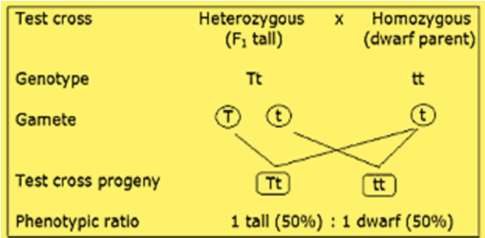
What is a test cross? Give examples.
Answer
439.9k+ views
Hint: Various types of crosses are done between organisms to determine their genotype and find individuals with a completely new genotype. These types of crosses are essential for scientific research as they help in knowing the genotype of each and every plant.
Complete answer :
In a test cross, a dominant phenotype organism is crossed with the homozygous recessive genotype organism in order to determine whether the dominant phenotype organism has homozygous dominant and heterozygous genotypes. Hence test cross is used to determine the zygosity of an organism with unknown genotype. This cross was first introduced by Gregor Mendel, father of genetics.
Consider the following example in plants: Suppose you have a tall and dwarf plant and tall characteristic (T) is dominant to dwarf(t). The dwarf plant must be homozygous for the recessive allele, but the genotype of the tall plant is unknown. It could be either TT or Tt. A testcross will decide the organism's genotype. The unknown genotype can be ascertained by examining the phenotypes of the resulting progeny. If crossing the unknown dominant phenotype (TT or Tt genotype) individual with the recessive phenotype individual produces only dominant phenotypes, then the plant with unknown genotype is homozygous dominant. If any recessive phenotypic plants emerge from the cross, then the unknown individual must possess the recessive allele, and have the heterozygous genotype.
Notes: In backcross, the F1 generation is crossbred with one of the parents or genetically identical individuals to the parent. A test cross is a type of back cross is the unknown dominant phenotypic generation is F1 progeny. But a backcross is not a test cross.

Complete answer :
In a test cross, a dominant phenotype organism is crossed with the homozygous recessive genotype organism in order to determine whether the dominant phenotype organism has homozygous dominant and heterozygous genotypes. Hence test cross is used to determine the zygosity of an organism with unknown genotype. This cross was first introduced by Gregor Mendel, father of genetics.
Consider the following example in plants: Suppose you have a tall and dwarf plant and tall characteristic (T) is dominant to dwarf(t). The dwarf plant must be homozygous for the recessive allele, but the genotype of the tall plant is unknown. It could be either TT or Tt. A testcross will decide the organism's genotype. The unknown genotype can be ascertained by examining the phenotypes of the resulting progeny. If crossing the unknown dominant phenotype (TT or Tt genotype) individual with the recessive phenotype individual produces only dominant phenotypes, then the plant with unknown genotype is homozygous dominant. If any recessive phenotypic plants emerge from the cross, then the unknown individual must possess the recessive allele, and have the heterozygous genotype.
Notes: In backcross, the F1 generation is crossbred with one of the parents or genetically identical individuals to the parent. A test cross is a type of back cross is the unknown dominant phenotypic generation is F1 progeny. But a backcross is not a test cross.

Recently Updated Pages
Master Class 12 Business Studies: Engaging Questions & Answers for Success

Master Class 12 English: Engaging Questions & Answers for Success

Master Class 12 Social Science: Engaging Questions & Answers for Success

Master Class 12 Chemistry: Engaging Questions & Answers for Success

Class 12 Question and Answer - Your Ultimate Solutions Guide

Master Class 11 Economics: Engaging Questions & Answers for Success

Trending doubts
Perianth occurs in family A Solanaceae B Fabaceae C class 12 biology CBSE

Why is chloroform kept in dark coloured bottles class 12 chemistry CBSE

What is the Full Form of PVC, PET, HDPE, LDPE, PP and PS ?

Why should a magnesium ribbon be cleaned before burning class 12 chemistry CBSE

How many ATP will be produced during the production class 12 biology CBSE

Which animal never drinks water in its entire life class 12 biology CBSE




